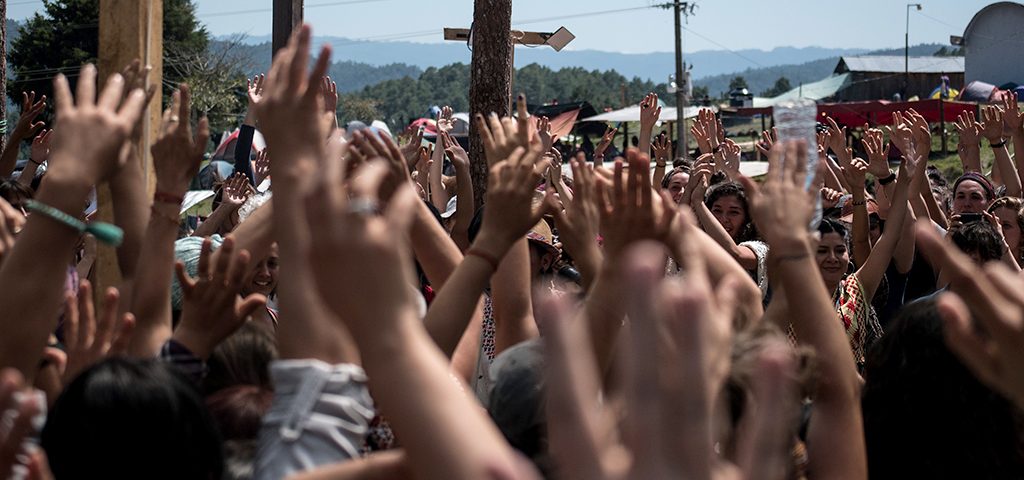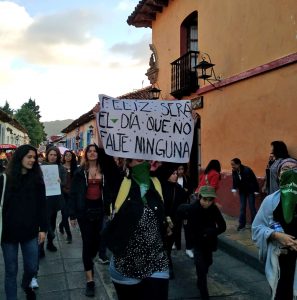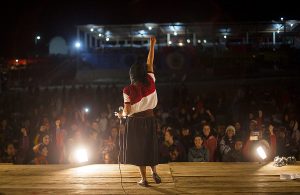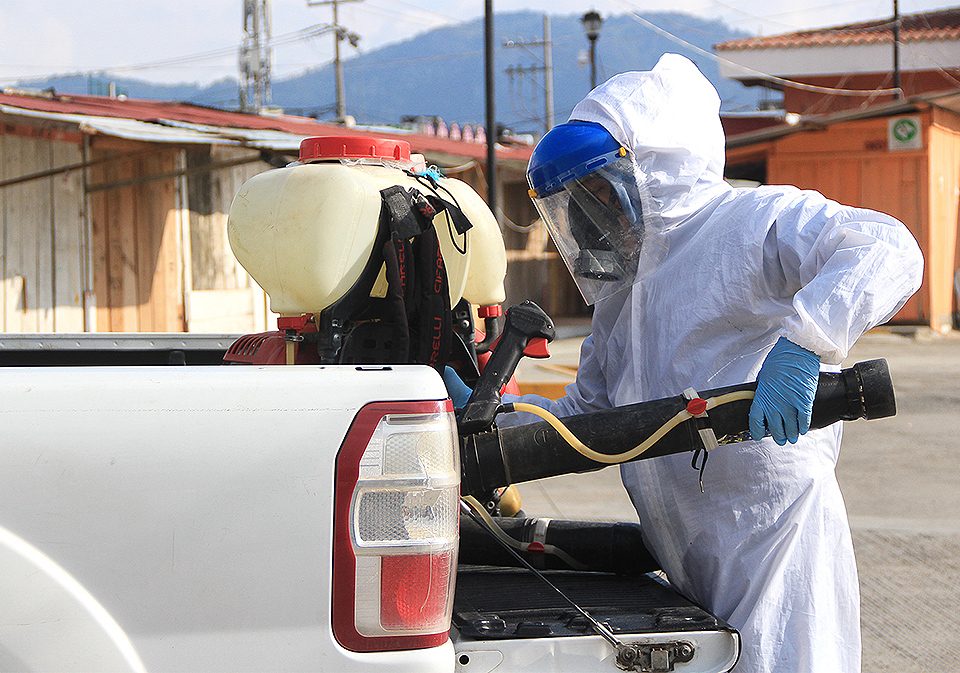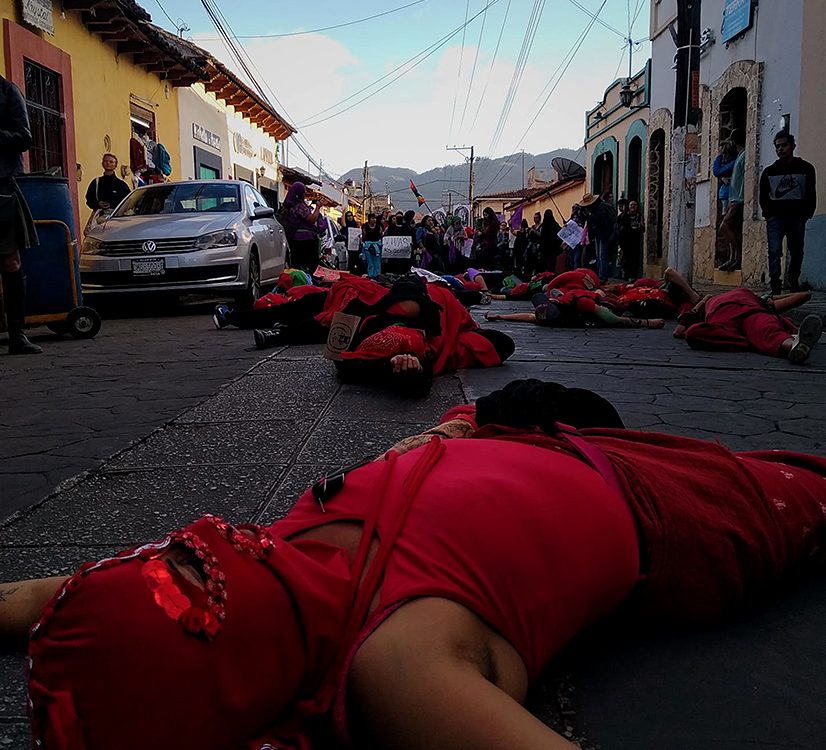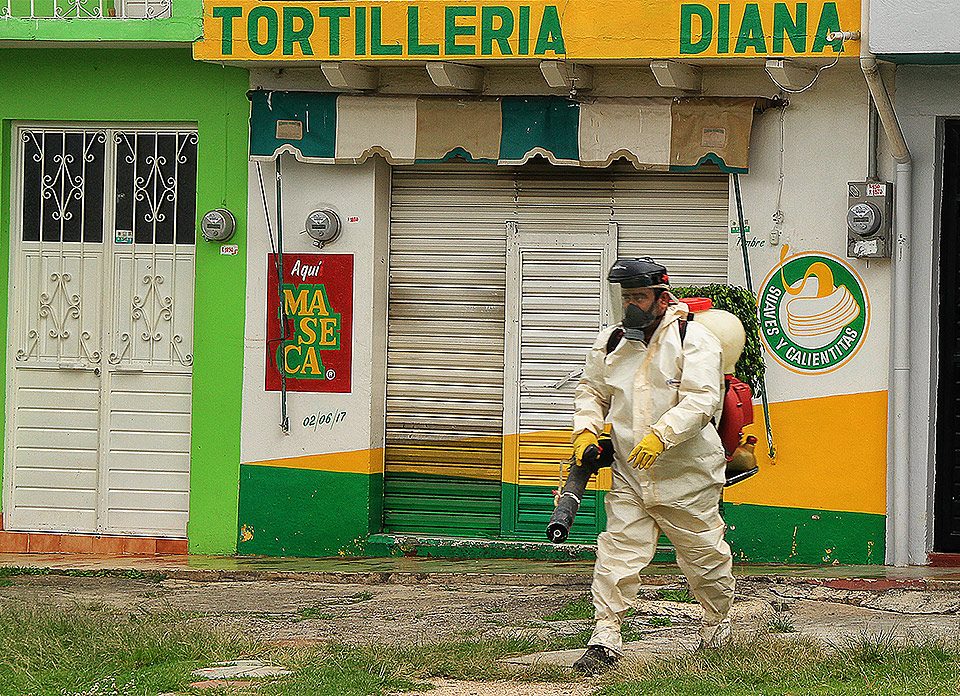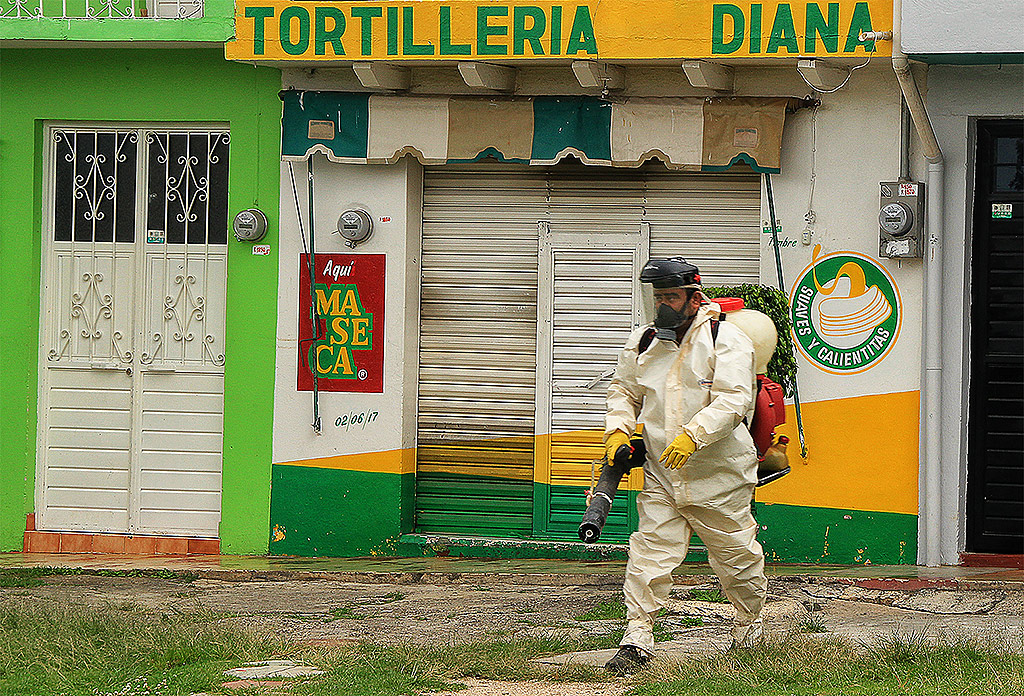
LATEST: Mexico – The risk of invisibility and aggravation of multiple pending human rights issues in the context of the pandemic
02/06/2020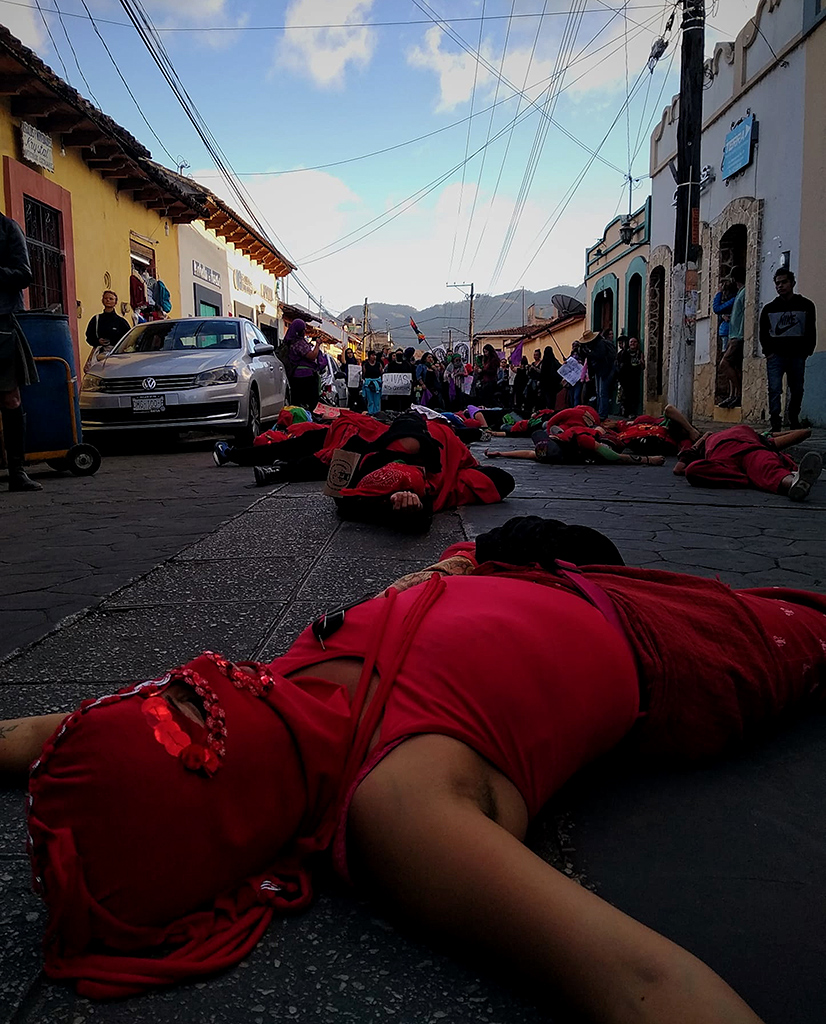
ARTICLE: Gender Violence during COVID-19 Lockdown
03/06/2020The gender-based violence pandemic, up to April 13th, has claimed more Mexican lives than COVID-19: 100 women have died from the coronavirus since it entered the country on February 28th, while 367 have been killed in that period .
Mexican machismo – the origin of the violence
These days the main topic in the news around the world is clearly the coronavirus pandemic that is the cause of COVID-19 lung disease and in many cases it structures life in a way that we have never anticipated. It dominates how we work, how we eat, how we communicate, in one way or another it affects us all. However, in times like these, it is easy to forget about another pandemic that has been affecting Mexico for centuries, one of the ugliest aspects of this country: femicidal violence.
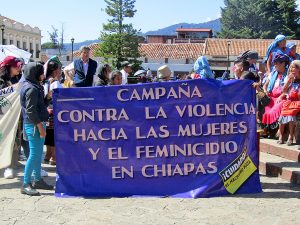
International Day for the Elimination of Violence against Women, San Cristóbal de Las Casas, November 2019 © SIPAZ
It is a well-known fact that Mexico is one of the most dangerous countries in the world for women and girls. Over the past year, there have been ten murders of them per day, according to statistics. Even more worrying is the fact that those numbers have increased dramatically in the past five years. Data from the Ministry of Security and Citizen Protection show that between 2015 and 2019, there was a 77% increase in the total number of intentional deadly crimes against women.
It is worth mentioning that most of these crimes are not registered as femicides, but as intentional homicides.
The roots of gender violence lie in the long history of macho culture in Mexico. In the pre-Hispanic world, women were already considered as devalued and inferior beings, but along with the Spanish conquerors in the 15th century, new dimensions of inequality and repression arrived. Women were excluded from society, from the outside world. They could only deal with domestic life while men had the power to control their lives.
Machismo, the main cause of femicidal violence, is the ideal of virility that considers everything feminine to be bad. “[It is] the expression of the magnification of the masculine in detriment of the constitution, the personality and the feminine essence; the exaltation of physical superiority, brute force and the legitimation of a stereotype that recreates and reproduces unjust power relations[1].”
In Mexico, machismo is “part of the way of being, of the popular character, of the collective unconscious”[2] and although it can be recognized that in the last 20 years the feminist movement in Latin America has grown considerably, there is no doubt that gender violence is still fairly standardized in Mexican society.
The Turn of the Millennium in Ciudad Juarez
The beginning of the new millennium represented a break, both in the political world and in the discourse on gender violence in Mexico. In the 1990s, Ciudad Juarez gained international attention for a series of femicides that began to be documented from January 1993. Until 2018, approximately 1,775 murders of women in that city were recorded.
The increase in victims of femicidal violence is directly related to the establishment of the North American Free Trade Agreement (NAFTA) in 1994, which caused a new migration of young women looking for work and a more independent life in the sweatshops of the Northern border. It was precisely these women who were particularly vulnerable, and therefore often the victims of femicidal violence.
In the case of the Ciudad Juarez feminicides, the attitude of the government authorities has been strongly criticized. In 2006, a study was published that stated that “while around 400 girls and women have been kidnapped and murdered, few arrests and convictions that have been enforced” [3], in addition to the fact that the accused and convicted persons claimed to have been tortured by the police before confessing to the crimes.
Government Measures: General Law on Women’s Access to a Life Free of Violence
In response to the enormous impunity of the femicides in Ciudad Juarez, feminist organizations and collectives demanded that the government take adequate measures to facilitate the investigation processes in these cases, as well as give access to justice to all victims of gender violence. In order to “give visibility and permanence to gender issues on the public agenda,” [1] the National Institute for Women (INMUJERES) was created in 2001. Two years later, the Commission to Prevent and Eradicate Violence against Women (CONAVIM) followed, which first focused on the context of Ciudad Juarez, and expanded to the national territory in 2009.
In the Legislature from 2003 to 2006, the largest number of women was recorded in the Chamber of Deputies (about 25%) up to then, the General Law on Women’s Access to a Life Free of Violence (LGAMVL) began to be discussed.
This law recognizes the different forms of violence against women, which include psychological, physical, sexual, economic and patrimonial violence, among others. In addition, it proposes institutional coordination to prevent, protect and eradicate violence and has a budget to ensure the implementation of the proposals.
Government Measures: Gender Violence against Women Alert
On top of this, a mechanism was established, which aims to implement a set of emergency government actions to confront and eradicate femicidal violence. Since 2007, the Gender Violence against Women Alert (GVWA) can be declared in a specific territory, be it a municipality or a federal state, in which “there is a serious situation of violence against women associated with machista and patriarchal practices persistent in society.” [2] For the GVWA to be declared, it must be requested by one or more human rights organizations, then a working group is formed to evaluate the application and later decide on its admission.
To date, Gender Violence Alerts have been declared in 13 states of Mexico, including Chiapas and Guerrero.
Without a doubt, the GVWA is an important signal that recognizes the state of emergency due to the serious situation of gender violence. However, human rights organizations have observed that in many cases emergency actions are launched, “without reflecting substantial changes in the number of femicides or the conditions in which women live.” [3]
Government Measures: PROIGUALDAD
During the six-year term of office of Peña Nieto, the National Program for Equal Opportunity and Non-Discrimination against Women (PROIGUALDAD) was established in the 2013-2018 National Plan, which sought to respond to the commitments signed by the Mexican State within the framework of international conventions and agreements[4]. In this, as in many other cases, there is the criticism that programs are only announced, but no results are presented. Regarding PROIGUALDAD, they should have been presented last November, but are still being overseen by the Ministry of Finance and Public Credit.
President Lopez Obrador’s Stance
President Andres Manuel Lopez Obrador (AMLO), who has been in office for just over a year, has publicly spoken out against gender violence. In the framework of International Women’s Day on March 8th, 2020, the president stated that “gender violence is incompatible with the Fourth Transformation” and that “we are sure that we will reduce crime rates and femicides.”
He highlighted the achievement of gender parity in the Cabinet of the Presidency and the fact that for the first time in the history of Mexico the Ministry of the Interior is headed by a woman, Olga Sanchez Cordero. In addition, he stressed that 60% of the people who benefit from his government’s social programs are women.
Feminist organizations and activists have criticized that, although AMLO denies being like other presidents, he “maintains the same policy of concealment as his predecessors” as regards gender violence. “There is a lack of understanding, a need or a folly of not wanting to recognize that discrimination and violence against women is very serious. This resistance starts from a conservative vision in all ideological groups, not only liberals”, said Maria de la Luz Estrada, coordinator of the National Citizen Observatory of Femicide.
Despite several protests in front of the National Palace in Mexico City and the thousands of voices of feminist activists demanding a change in policy, the President of the Republic maintains the position that “contrary to what the ‘conservatives’ say, his government does not pretend to fight violence” and that “impunity no longer exists.”
Marching and Singing against Patriarchy
2019 was marked by the feminist movement not only here in Mexico but also globally. In March, the #MeToo movement that originated in the United States in 2017 spread to the neighboring country and caused more than 400,000 Mexican women to denounce their abusers on social media[1].
A series of feminist protests began last August that continued until March 9th of this year. Initially, it was sparked by several complaints of police violence in Mexico City (CDMX). Four members had sexually abused a minor without receiving any sanction. Then it was revealed that the legal doctor had not followed the procedure, so there were no expert medical tests. There was not even an arrest warrant against the perpetrators.
In the following days, the complaints of a minor who suffered sexual abuse by a member of the Industrial Banking Police of the Photography Archive Museum, and a woman who was allegedly harassed by CDMX police officers on the street were reported.
These cases caused huge outrage that made it possible for a demonstration to be organized in a short period of time to denounce police violence, which took place on August 12th, 2019. Four days later, on August 16th, the women of CDMX demonstrated for the second time. During the marches some protesters broke windows and painted the Insurgentes Metrobus station. Also the monument of the Angel of Independence was vandalized.
The Mexican press reports focused mainly on the material damage resulting from the protests, forgetting the causes of the mobilizations. A discourse was built in which women were not victims but victimizers. “It privileged the idea that women’s anger is irrational and misplaced, when all the evidence points to gender violence being a systematic phenomenon, with historical roots and with daily events that reproduce it. Considering that material damages are greater than human and social damages is also a form of violence”, declared the feminist group Mujeres + Mujeres regarding media coverage.
In November, in the context of protests in Chile, another movement emerged known as “Un violador en tu camino” (A Rapist on your Path). Faced with violations of women’s rights by the Chilean State, the army and the Carabineros, the feminist collective “Lastesis” created a participatory protest performance, consisting of a choreography and a song against patriarchy. The song went around the world. On November 25th, thousands of activists from Chile, Colombia, Spain, France, Mexico, USA, Argentina and many more performed the song in their corresponding countries within the framework of International Day to Eliminate Violence against Women.
A Mexico without Women
In January of this year alone, a total of 320 murdered women were registered, of whom 72 were classified as femicides and 248 as intentional homicides. The femicide of Ingrid Escamilla Vargas in particular became known due the spread of images of her lifeless body. Ingrid, 25, was skinned by her partner on February 9th in Mexico City.
The subsequent distribution of photos of the victim’s body on social networks caused outrage in public opinion and a debate on the role of the media. Next, Claudia Sheinbaum, the mayor of Mexico City, stated that the dissemination of the images would be sanctioned. In addition, she announced a specific law proposal to punish the distribution of images of crime victims by public officials.
For March 8th, 2020, International Women’s Day, the Feminist Assembly “Juntas y Organizadas” (Together and Organized), announced a march in Mexico City. A historical number of around 80 thousand participants was registered. In addition to the CDMX march, demonstrations were held in more than 20 Mexican cities, including Oaxaca and San Cristobal de Las Casas, in Chiapas.
On February 18th, the Veracruz feminist collective “Brujas del mar” (Sea Witches) had called for a national women’s strike on March 9th under the hashtag #ElNueveNingunaSeMueve (Nobody moves on the 9th). The objective of that action was to demonstrate how the country would look if there were no women, in addition to highlighting the importance of women for the Mexican economy. The concept of a national women’s strike was not particularly new. The first time a similar action known as “Women’s Day Off” was carried out in Iceland in 1975. It was then repeated in several countries around the world until it reached Mexico in 2020.
On March 9th, it was calculated that a total of 22 million women did not show up to work across the country. As for the effect that strike had on the economy, it is difficult to assess: we must take into account the setbacks in the world economy caused by the COVID-19 pandemic, and the decrease in oil prices in March that also caused a devaluation of the Mexican peso. In any case, it can be said that the economic losses caused by the women’s strike were higher than anticipated.
According to the Mexican Association of Human Resources Management (AMEDIRH), an economic impact was calculated at around one and a half billion dollars lost in total, which is equivalent to more than half of the Gross Domestic Product (GDP) generated in Mexico per day.
Fighting Violence – With Men, not against Them
In 1996, Zapatista women achieved the prohibition of the consumption of alcoholic beverages and drugs, which was one of the main causes of domestic violence in the Zapatista communities in Chiapas. This example demonstrates the importance of actions between men and women to achieve the elimination of gender violence.
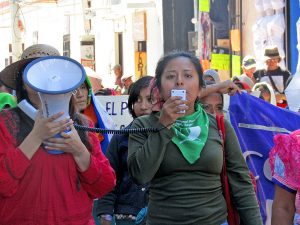
International Day for the Elimination of Violence against Women, San Cristóbal de Las Casas, November 2019 © SIPAZ
Although it is true that in recent years more and more attention has been paid to the issue of gender-based violence, there is no doubt that this development has also caused a strong polarization on the subject. Especially, in times of digitization, the image of the “feminazi”, the person who hates men, is spread, and along with this a mistaken perception of what feminism poses. For this reason, it is necessary that men also contribute to change Mexican society towards greater equity.
In Chiapas, the “Hombres G” (G Men) group, which belongs to the Centre for Comprehensive Grassroots Education (CEIBA) does just that. Since 1998 they have been working on gender with men and have masculinities workshops in order to “reflect on how our masculine, patriarchal, hegemonic, controlling condition is constructed from a deeply violent culture.”
“The idea is to sensitize ourselves in the first place, but above all to transform ourselves and transform our practices in a personal sense, but not only, we need to go beyond individual reflection and this implies a social commitment to community and especially collective work”, Abelardo Palmo Molina, one of the facilitators of the workshops explained.
The collective cooperates with indigenous and peasant organizations in the Chiapas border area. Palmo Molina emphasized the importance of working on the gender issue with men in alliance with organized women: “The vast majority of men who come to this space are partners of women who are already organized and who have thought for years about the gender issue and need their partner or son or grandfather or cousin to reflect on not continuing to reproduce violence in the family, at home, not continuing to have practices that do not allow the growth of female partners.”
The meetings have a direct impact on the families of the participants. They benefit couples, sons and daughters. The “Hombres G” also carry out mixed workshops, in which some women have shared their experience. They said that they were really observing a change in their life partner, for example, that they listened more or showed more affection.
For women to live a free and fearless life in Mexico, there needs to be a change in society, a change in Mexican culture that comes from machismo. The work of “Hombres G” shows, although through small steps, how this deeper social and cultural change can be achieved.
Notes:
- [1] ONU
- [2] Lugo, Carmen: Machismo y violencia, 1985
- [3] Ibid.
- [4] Pantaleo, Katherine: Gendered Violence: An Analysis of the Maquiladora Murders, 2010
- [5] Fundar: Retos y aportaciones de la Ley General de Acceso de las Mujeres a una Vida Libre de Violencia
- [6] CONAVIM
- [7] Fundar
- [8] Convención para la Eliminación de Todas las Formas de Discriminación contra la Mujer (CEDAW); Convención Interamericana para Prevenir, Sancionar y Erradicar la Violencia contra la Mujer (Belém Do Pará)
- [9] Leer más: Informe SIPAZ Junio 2019, #MeTooMX: El grito de las mujeres en un contexto de violencia omnipresente
Sources:
- CNDH: Violencia de Género
- UNICEF: Violencia de género
- ONU Mujeres: Violencia contra las mujeres: la pandemia en la sombra
- Wikipedia: Violencia de género en México
- Letras Libres: Violencia de género y feminicidios en México: los datos hablan
- Animal Político: #8M: Como nunca antes, una potente marcha de mujeres lanza grito contra el machismo y violencia feminicida
- Wikipedia: Protestas feministas en México de 2019
- Wikipedia: Un violador en tu camino
- Wikipedia: Protesta feminista en México de 2020
- Infobae: De Ingrid a Fátima: radiografía de los feminicidios en México, una emergencia nacional
- Wikipedia: Feminicidios en Ciudad Juárez
- El Heraldo de México: En 25 años van 1,779 feminicidios en Ciudad Juárez
- Fundar: Retos y aportaciones de la Ley General de Acceso de las Mujeres a una Vida Libre de Violencia
- INMUJERES: Alerta de Violencia de Género contra las Mujeres
- López Obrador: Violencia de género es incompatible con la 4T: presidente AMLO; se compromete a acabar con feminicidios
- Milenio: AMLO: conservador y simulador ante violencia de género
- The Washington Post: México abandona a las mujeres violentadas en esta contingencia

